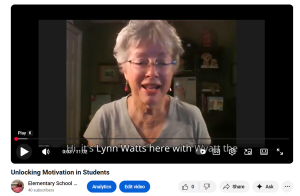Unlocking Motivation: Helping Students Choose Success
In today’s educational environment, we are more aware than ever that student motivation and engagement is essential for lasting learning. I can’t tell you how many times as a school counselor, I had discussions with teachers, parents and kids about being motivated. However, I’m afraid we rarely discussed how important intrinsic motivation is vs. extrinsic motivation. In our fast paced pressure cooker world, we were often simply focused on what would work quickly and with the least effort. Unfortunately, when we talk about motivating students, with rewards and consequences, we lose sight of the fact that they are already motivated — just often not to do what the adults want them to do! Understanding motivation is important, but we need to work with students’ motivational systems that are already in place, rather than impose motivation from the outside (i.e. extrinsically).
Motivation is one of the most powerful drivers of student success. While rewards and consequences may create short-term compliance, true motivation comes from within. As elementary school counselors, we have the unique opportunity to help students tap into their intrinsic need for personal autonomy, self-determination, and the sense that their choices matter.
When students feel empowered rather than controlled, they are more likely to engage in learning, persevere through challenges, and build positive relationships. Research in self-determination theory highlights three essential characteristics of a motivating environment: autonomy, relatedness, and competence.
Key Characteristics of a Motivating Environment
1. Autonomy
-
Definition: Autonomy means students feel they have a voice and a choice in their learning and behavior. It’s not about letting them do whatever they want—it’s about giving them opportunities to make meaningful choices.
-
Benefits: Students who experience autonomy are more engaged, take greater ownership of their learning, and develop stronger problem-solving skills.
2. Relatedness
-
Definition: Relatedness is the sense of connection and belonging students feel with peers, teachers, and counselors.
-
Benefits: Students who feel connected are more motivated to learn, more resilient when facing challenges, and more willing to contribute positively to the classroom community.
3. Competence
-
Definition: Competence means students feel capable of meeting expectations and mastering new skills.
-
Benefits: When students believe they are competent, they are more likely to embrace challenges, persist through difficulties, and build confidence.
How Counselors Can Create a Motivating Environment
-
Encourage student choice: Allow students to select activities, brainstorm solutions, or set personal goals. Even small decisions increase their sense of control.
-
Build strong connections: Greet students by name, listen actively, and create opportunities for teamwork and peer support.
-
Highlight progress and effort: Recognize growth, not just achievement. Help students see how their efforts lead to improvement.
-
Model intrinsic motivation: Share stories of your own learning and perseverance to inspire students.
Classroom Strategies to Foster Motivation
-
Choice Boards – Provide students with a menu of activities to complete a lesson objective, allowing them to select how they demonstrate learning.
-
Goal-Setting Conferences – Meet individually or in small groups to help students set short, achievable goals and celebrate their progress.
-
Peer Collaboration – Use partner or group activities to build connection and belonging.
-
“I Can” Statements – Frame learning objectives in student-friendly terms so they see what they are capable of achieving.
-
Reflection Journals – Encourage students to reflect on what they did well, what challenged them, and what strategies helped them succeed.


[…] Encourage initiative and ownership. If they want to start a lemonade stand or create a neighborhood newspaper, help them think through the details. Teach them about supply and demand, marketing, profit and loss. Have them purchase the supplies so they understand what it means to make a profit. Share stories of how you started a business at their age or of well-know entrepreneurs and the businesses they started as kids. For instance, Tony Hsieh, owner of Zappos shoes made and sold spirit wear buttons as a teen-ager and Warren Buffet sold chewing gum door to door. There are lots of kids today who have created businesses that are highly profitable: 8 kids making a million dollars […]